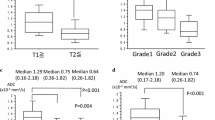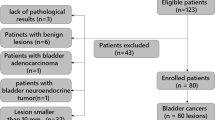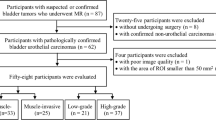Abstract
Purpose
To explore associations of whole-lesion histogram diffusion metrics with pathologic findings and subsequent metastatic disease in bladder cancer patients undergoing radical cystectomy.
Methods
Twenty-three bladder cancer patients (21M, 2F; mean 70 ± 11 years) underwent MRI before cystectomy. A volume-of-interest was placed on all slices on the ADC map encompassing each lesion. Whole-lesion mean, kurtosis, and skewness of ADC were calculated and compared with T stage and pelvic nodal status at cystectomy and with subsequent metastasis in 20/25 patients with available follow-up.
Results
At cystectomy, 39 % (9/23) were stage T2, 61 % (14/23) ≥T3, and 28 % (5/23) exhibited positive nodes; 35 % (7/20) developed later metastases. Mean ADC was significantly lower in stage ≥T3 than in lower stage tumors (1.20 ± 0.36 × 10−3 vs. 1.55 ± 0.36 × 10−3 mm2/s; p = 0.044), but showed no association with nodal or metastatic disease (p = 0.362–0.709). Kurtosis was significantly lower in tumors with, compared to without, nodal disease (−0.05 ± 0.29 vs. 0.91 ± 1.16; p = 0.037), and showed a non-significant decrease in tumors with, compared to without, later metastases (0.23 ± 0.63 vs. 0.83 ± 0.89; p = 0.088). Kurtosis was not associated with T stage (p = 0.811), and skew was not associated with any outcome (p = 0.516–0.643). Mean ADC achieved highest AUC for identification of stage ≥T3 (AUC = 0.754 vs. 0.516–0.643 for other metrics). Kurtosis achieved highest AUC for nodal disease (AUC = 0.811 vs. 0.522–0.556 for other metrics) and metastases (AUC = 0.736 vs. 0.516–0.626 for other metrics). Only difference in AUC between skewness and kurtosis for nodal disease was significant (p = 0.031).
Conclusion
While requiring larger studies, kurtosis has potential to complement mean ADC in bladder cancer prognosis using whole-lesion histogram analysis.


Similar content being viewed by others
References
American Cancer Society (2013) Cancer facts and figures 2013. Atlanta: American Cancer Society
Verma S, Rajesh A, Prasad SR, et al. (2012) Urinary bladder cancer: role of MR imaging. Radiographics 32(2):371–387. doi:10.1148/rg.322115125
Vikram R, Sandler CM, Ng CS (2009) Imaging and staging of transitional cell carcinoma: part 1, lower urinary tract. Am J Roentgenol 192(6):1481–1487. doi:10.2214/AJR.08.1318
Gschwend JE, Dahm P, Fair WR (2002) Disease specific survival as endpoint of outcome for bladder cancer patients following radical cystectomy. Eur Urol 41(4):440–448
Ghoneim MA, Abdel-Latif M, el-Mekresh M, et al. (2008) Radical cystectomy for carcinoma of the bladder: 2,720 consecutive cases 5 years later. J Urol 180(1):121–127. doi:10.1016/j.juro.2008.03.024
Grossman HB, Natale RB, Tangen CM, et al. (2003) Neoadjuvant chemotherapy plus cystectomy compared with cystectomy alone for locally advanced bladder cancer. N Engl J Med 349(9):859–866. doi:10.1056/NEJMoa022148
International Collaboration of T, Medical Research Council Advanced Bladder Cancer Working P, European Organisation for R, et al. (2011) International phase III trial assessing neoadjuvant cisplatin, methotrexate, and vinblastine chemotherapy for muscle-invasive bladder cancer: long-term results of the BA06 30894 trial. J Clinical Oncol 29(16):2171–2177. doi:10.1200/JCO.2010.32.3139
Raj GV, Karavadia S, Schlomer B, et al. (2011) Contemporary use of perioperative cisplatin-based chemotherapy in patients with muscle-invasive bladder cancer. Cancer 117(2):276–282. doi:10.1002/cncr.25429
Kobayashi S, Koga F, Yoshida S, et al. (2011) Diagnostic performance of diffusion-weighted magnetic resonance imaging in bladder cancer: potential utility of apparent diffusion coefficient values as a biomarker to predict clinical aggressiveness. Eur Radiol. doi:10.1007/s00330-011-2174-7
Funatsu H, Imamura A, Takano H, Ueda T, Uno T (2012) Can pretreatment ADC values predict recurrence of bladder cancer after transurethral resection? Eur J Radiol 81(11):3115–3119. doi:10.1016/j.ejrad.2012.06.009
Yoshida S, Kobayashi S, Koga F, et al. (2013) Apparent diffusion coefficient as a prognostic biomarker of upper urinary tract cancer: a preliminary report. Eur Radiol 23(8):2206–2214. doi:10.1007/s00330-013-2805-2
Rosenkrantz AB (2013) Histogram-based apparent diffusion coefficient analysis: an emerging tool for cervical cancer characterization? Am J Roentgenol 200(2):311–313. doi:10.2214/AJR.12.9926
Kyriazi S, Collins DJ, Messiou C, et al. (2011) Metastatic ovarian and primary peritoneal cancer: assessing chemotherapy response with diffusion-weighted MR imaging-value of histogram analysis of apparent diffusion coefficients. Radiology 261(1):182–192. doi:10.1148/radiol.11110577
Lista F, Andres G, Caceres F, et al. (2013) Evaluation of risk of muscle invasion, perivesical and/or lymph node affectation by diffusion-weighted magnetic nuclear resonance in the patient who is a candidate for radical cystectomy. Actas Urol Esp 37(7):419–424. doi:10.1016/j.acuro.2013.04.003
Donati OF, Mazaheri Y, Afaq A, et al. (2014) Prostate cancer aggressiveness: assessment with whole-lesion histogram analysis of the apparent diffusion coefficient. Radiology 271(1):143–152. doi:10.1148/radiol.13130973
Wheeler D (2004) Advanced topics in statistical process control, 2nd edn. Knoxville: SPC Press
Rosenkrantz AB, Haghighi M, Horn J, et al. (2013) Utility of quantitative MRI metrics for assessment of stage and grade of urothelial carcinoma of the bladder: preliminary results. Am J Roentgenol 201(6):1254–1259. doi:10.2214/AJR.12.10348
Kobayashi S, Koga F, Kajino K, et al. (2014) Apparent diffusion coefficient value reflects invasive and proliferative potential of bladder cancer. J Magn Reson Imaging 39(1):172–178. doi:10.1002/jmri.24148
Jensen JH, Helpern JA, Ramani A, Lu H, Kaczynski K (2005) Diffusional kurtosis imaging: the quantification of non-gaussian water diffusion by means of magnetic resonance imaging. Magn Reson Med 53(6):1432–1440. doi:10.1002/mrm.20508
Yoshida S, Koga F, Kobayashi S, et al. (2012) Role of diffusion-weighted magnetic resonance imaging in predicting sensitivity to chemoradiotherapy in muscle-invasive bladder cancer. Int J Radiat Oncol Biol Phys 83(1):e21–e27. doi:10.1016/j.ijrobp.2011.11.065
Rosenkrantz AB, Mussi TC, Spieler B, et al. (2012) High-grade bladder cancer: association of the apparent diffusion coefficient with metastatic disease: preliminary results. J Magn Reson Imaging 35(6):1478–1483. doi:10.1002/jmri.23590
Downey K, Riches SF, Morgan VA, et al. (2013) Relationship between imaging biomarkers of stage I cervical cancer and poor-prognosis histologic features: quantitative histogram analysis of diffusion-weighted MR images. Am J Roentgenol 200(2):314–320. doi:10.2214/AJR.12.9545
Kierans AS, Bennett GL, Mussi TC, et al. (2013) Characterization of malignancy of adnexal lesions using ADC entropy: comparison with mean ADC and qualitative DWI assessment. J Magn Reson Imaging 37(1):164–171. doi:10.1002/jmri.23794
Raj GV, Herr H, Serio AM, et al. (2007) Treatment paradigm shift may improve survival of patients with high risk superficial bladder cancer. J Urol 177(4):1283–1286 (discussion 1286). doi:10.1016/j.juro.2006.11.090
Knoedler JJ, Boorjian SA, Kim SP, et al. (2012) Does partial cystectomy compromise oncologic outcomes for patients with bladder cancer compared to radical cystectomy? A matched case-control analysis. J Urol 188(4):1115–1119. doi:10.1016/j.juro.2012.06.029
Author information
Authors and Affiliations
Corresponding author
Rights and permissions
About this article
Cite this article
Rosenkrantz, A.B., Obele, C., Rusinek, H. et al. Whole-lesion diffusion metrics for assessment of bladder cancer aggressiveness. Abdom Imaging 40, 327–332 (2015). https://doi.org/10.1007/s00261-014-0213-y
Published:
Issue Date:
DOI: https://doi.org/10.1007/s00261-014-0213-y




